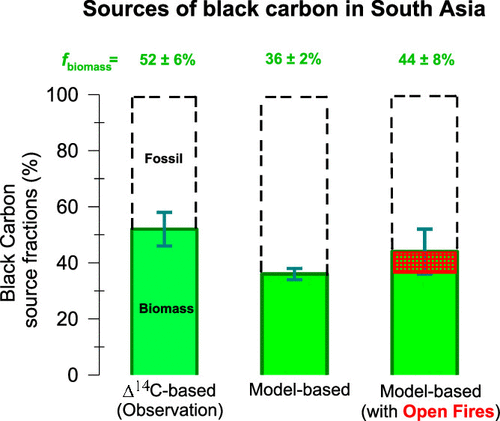当前位置:
X-MOL 学术
›
Environ. Sci. Technol.
›
论文详情
Our official English website, www.x-mol.net, welcomes your
feedback! (Note: you will need to create a separate account there.)
Source Quantification of South Asian Black Carbon Aerosols with Isotopes and Modeling.
Environmental Science & Technology ( IF 10.8 ) Pub Date : 2020-09-04 , DOI: 10.1021/acs.est.0c02193 Sanjeev Dasari 1 , August Andersson 1 , Andreas Stohl 2 , Nikolaos Evangeliou 2 , Srinivas Bikkina 1 , Henry Holmstrand 1 , Krishnakant Budhavant 1, 3, 4 , Abdus Salam 5 , Örjan Gustafsson 1
Environmental Science & Technology ( IF 10.8 ) Pub Date : 2020-09-04 , DOI: 10.1021/acs.est.0c02193 Sanjeev Dasari 1 , August Andersson 1 , Andreas Stohl 2 , Nikolaos Evangeliou 2 , Srinivas Bikkina 1 , Henry Holmstrand 1 , Krishnakant Budhavant 1, 3, 4 , Abdus Salam 5 , Örjan Gustafsson 1
Affiliation

|
Black carbon (BC) aerosols perturb climate and impoverish air quality/human health—affecting ∼1.5 billion people in South Asia. However, the lack of source-diagnostic observations of BC is hindering the evaluation of uncertain bottom-up emission inventories (EIs) and thereby also models/policies. Here, we present dual-isotope-based (Δ14C/δ13C) fingerprinting of wintertime BC at two receptor sites of the continental outflow. Our results show a remarkable similarity in contributions of biomass and fossil combustion, both from the site capturing the highly populated highly polluted Indo-Gangetic Plain footprint (IGP; Δ14C-fbiomass = 50 ± 3%) and the second site in the N. Indian Ocean representing a wider South Asian footprint (52 ± 6%). Yet, both sites reflect distinct δ13C-fingerprints, indicating a distinguishable contribution of C4-biomass burning from peninsular India (PI). Tailored-model-predicted season-averaged BC concentrations (700 ± 440 ng m–3) match observations (740 ± 250 ng m–3), however, unveiling a systematically increasing model-observation bias (+19% to −53%) through winter. Inclusion of BC from open burning alone does not reconcile predictions (fbiomass = 44 ± 8%) with observations. Direct source-segregated comparison reveals regional offsets in anthropogenic emission fluxes in EIs, overestimated fossil-BC in the IGP, and underestimated biomass-BC in PI, which contributes to the model-observation bias. This ground-truthing pinpoints uncertainties in BC emission sources, which benefit both climate/air-quality modeling and mitigation policies in South Asia.
中文翻译:

同位素和建模对南亚黑碳气溶胶的源定量。
黑炭(BC)气溶胶扰乱了气候,空气质量/人类健康状况恶化,影响了南亚约15亿人口。但是,缺乏对卑诗省的源诊断结果,阻碍了对不确定的自下而上排放清单(EI)的评估,从而也阻碍了模型/政策的评估。在这里,我们本双同位素基(Δ 14 C /δ 13 C)在大陆流出两种受体部位冬季BC的指纹。我们的研究结果显示,生物质和化石燃烧的贡献显着的相似,无论是从现场拍摄人口稠密的严重污染印度河-恒河平原足迹(IGP;Δ 14个C- ˚F生物质= 50±3%),在印度洋北部的第二个站点代表了更广泛的南亚足迹(52±6%)。然而,这两个网站反映不同δ 13 C-指纹,定义了C的区分贡献4从印度半岛(PI)-biomass燃烧。定制模型预测季节平均BC的浓度(700±440纳克米-3)匹配观测(740±250ng的米-3),然而,拉开了系统地增加模型的观测偏压(+ 19%至-53%)整个冬天。单独从露天焚烧中掺入BC并不能调和预测(f生物量= 44±8%)。直接的源分离比较显示,EIs的人为排放通量,IGP中的高估化石-BC和PI中低估了生物量-BC的区域性抵消,这导致了模型观测的偏差。这一事实真切地指出了不列颠哥伦比亚省排放源的不确定性,这既有利于南亚的气候/空气质量模拟,也有利于缓解政策。
更新日期:2020-10-06
中文翻译:

同位素和建模对南亚黑碳气溶胶的源定量。
黑炭(BC)气溶胶扰乱了气候,空气质量/人类健康状况恶化,影响了南亚约15亿人口。但是,缺乏对卑诗省的源诊断结果,阻碍了对不确定的自下而上排放清单(EI)的评估,从而也阻碍了模型/政策的评估。在这里,我们本双同位素基(Δ 14 C /δ 13 C)在大陆流出两种受体部位冬季BC的指纹。我们的研究结果显示,生物质和化石燃烧的贡献显着的相似,无论是从现场拍摄人口稠密的严重污染印度河-恒河平原足迹(IGP;Δ 14个C- ˚F生物质= 50±3%),在印度洋北部的第二个站点代表了更广泛的南亚足迹(52±6%)。然而,这两个网站反映不同δ 13 C-指纹,定义了C的区分贡献4从印度半岛(PI)-biomass燃烧。定制模型预测季节平均BC的浓度(700±440纳克米-3)匹配观测(740±250ng的米-3),然而,拉开了系统地增加模型的观测偏压(+ 19%至-53%)整个冬天。单独从露天焚烧中掺入BC并不能调和预测(f生物量= 44±8%)。直接的源分离比较显示,EIs的人为排放通量,IGP中的高估化石-BC和PI中低估了生物量-BC的区域性抵消,这导致了模型观测的偏差。这一事实真切地指出了不列颠哥伦比亚省排放源的不确定性,这既有利于南亚的气候/空气质量模拟,也有利于缓解政策。











































 京公网安备 11010802027423号
京公网安备 11010802027423号